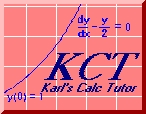

The problem was to find the limit:
lim x e-x
x > ¥
There are two ways you are likely to have tried L'Hopital's Rule on this one. One is to observe that
1
e-x =
ex
and then set it up as
x
lim
x > ¥ ex
which is the approach that leads to a solution. If instead you
tried
e-x
lim
x > ¥ 1
x
you undoubtably found that applying L'Hopital's rule to the above
doesn't seem to help you toward a solution (even though both numerator
and denominator do go to zero as x goes to infinity). You should
know that very often on these L'Hopital problems, there are two possible
ways you can go, but only on leads easily to a solution. Sometimes you
just have to try them both.
So let's pursue the
x
lim
x > ¥ ex
setup. Clearly both numerator and denominator go to infinity as x
goes to infinity. So this expression is a candidate for applying L'Hopital's
rule. We take the derivatives of both the numerator and denomonator and
make the new quotient:
x 1
lim = lim = lim e-x = 0
x > ¥ ex x > ¥ ex x > ¥
which completes the solution.
email me at hahn@netsrq.com